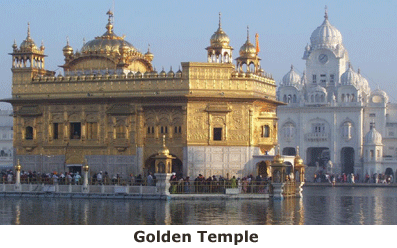Golden Temple................................................................................................................................................................................................................................................................................... The city of Amritsar was built around the Golden Temple and the Amrit Sarovar lake, from which it derives its name. Surrounded by a fortified wall with eighteen gates, the temple complex has its main north entrance under a Victorian clock tower known as the Darshani Deori. The entrance is up a flight of steps and down again to the temple and holy tank. The Golden Temple sits on a rectangular platform in the centre of the Amrit Sarovar. It is surrounded by a white marble corridor, through which pilgrims visiting the shrine walk, circumnavigating the temple. A narrow causeway links the Harmandir, or Darbar Sahib, as the temple is also called. The entrance to the temple is through an ornate archway with intricate inlay work, inscribed with verses from the Granth Sahib.
The temple building is three storeys high and is crowned with a dome shaped like an inverted lotus. The lower storey is in white marble, while the two upper storeys have gold plating. The temple has four entrances instead of the usual single entry, symbolic of the openness of Sikhism and the fact that followers of all faiths are welcome here. The walls within are decorated with carved wooden panels and elaborate inlay work in silver and gold. The Adi Granth, compiled by Guru Arjan Dev, rests on a throne beneath a jewel-encrusted canopy. Priests continuously recite verses from the holy book in 3-hour shifts. A complete reading of the text takes 48 hours. The Akal Takht, next to the Golden Temple, is the seat of the Shiromani Gurudwara Prabandhak Committee, the religious governing body of the Sikhs. The building of the Akal Takht was begun by Guru Arjan Dev and completed in 1609 by Guru Hargobind. The Adi Granth is housed in the Akal Takht and is taken out in procession every morning to be placed at the Harmandir, and is brought back to the Akal Takht at night. Shrines on the northern edge of the corridor are venerated as the 68 holy shrines of the Hindus. According to the teachings of Guru Arjan Dev, it was enough for the devout to visit these shrines and not visit all the original Hindu shrines which are distributed across India. Many of these shrines have now been converted into a martyrís gallery showing the gruesome history of the Sikhs. Around the Parikrama, or pathway, are four rectangular cubicles where Granthis (priests) sit and recite the Granth Sahib. Pilgrims leave offerings at the steps, and can also get the holy book recited in their names for a donation.
The Jubi tree, at the northwestern corner of the complex,
was planted some 450 years ago by the templeís first head
priest. The old, gnarled tree is believed to have special
powers and childless women tie strips of cloth on it to be
blessed with sons. Marriage deals are also fixed under the
tree, though this practice is disapproved of by the temple
authorities. As the religious capital of Punjab-and one of Indiaís most important cities- Amritsar is well connected by plane, train and road to the rest of the country. Amritsarís Rajasansi Airport has air links to Delhi, Srinagar and Chandigarh; the local train station has regular trains to most major cities in the country.
In addition to air and rail connections, Amritsar also has
frequent bus services from cities and towns both within
Punjab as well as in other states. Besides this, thereís a
bus service from Lahore (35 km away), the only overland
service between India and Pakistan. When to go The Golden Temple, and the city of Amritsar itself, are best visited in the winter. The months between November and March are pleasant (even cold), although the summer can get blisteringly hot. Accommodation and other facilities Amritsar has a number of mid-range and luxury hotels- the latter mainly along Mall Road. There are smaller guesthouses too, and a youth hostel which houses the Punjab Tourism Development Corporation office. Besides these, there is accommodation at the Golden Temple itself; the Guru Ram Das and Guru Nanak hostels on one side of the complex offer free accommodation up to three nights for visitors. All across Amritsar are restaurants and eateries galore, where apart from the local food, you can also get international cuisine, although usually not too authentic. If youíre visiting the temple, however, itís best to go to the langar for a taste of traditional Sikh hospitality. The `Guru-ka-langarí or community canteen is a Sikh institution, which was started by Guru Amar Das in the 16th century. The practice of eating together encouraged shedding of inhibitions and the principle of equality. The community kitchen at the Golden Temple feeds up to 10,000 people in a day, free of charges. |
|||||||
|
|
|||||||




